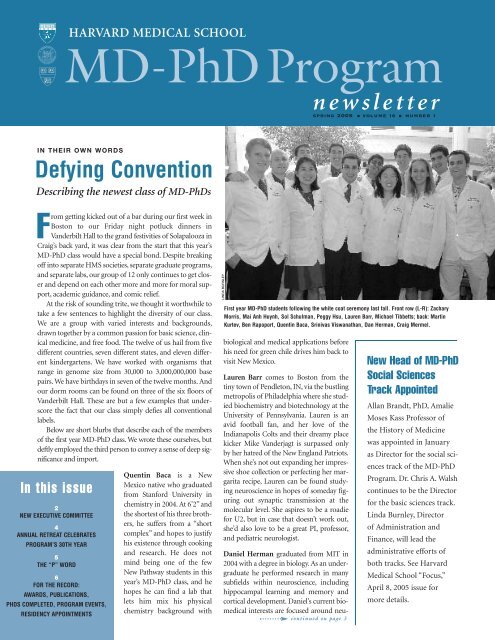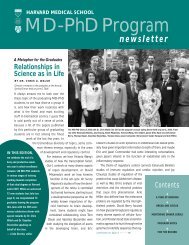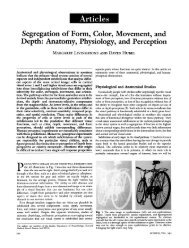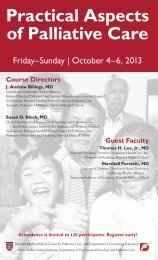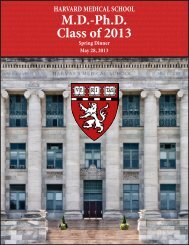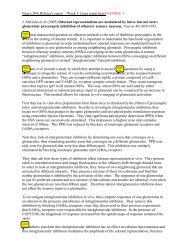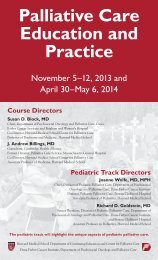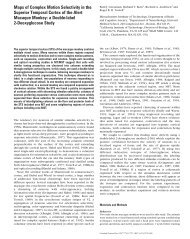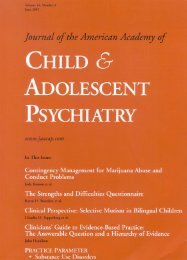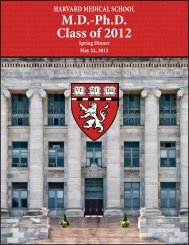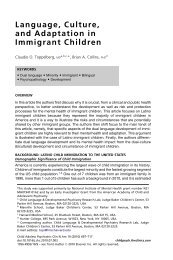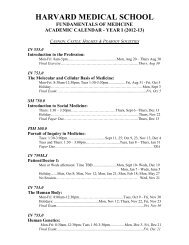MD-PhDProgram - Harvard Medical School - Harvard University
MD-PhDProgram - Harvard Medical School - Harvard University
MD-PhDProgram - Harvard Medical School - Harvard University
- No tags were found...
Create successful ePaper yourself
Turn your PDF publications into a flip-book with our unique Google optimized e-Paper software.
HARVARD MEDICAL SCHOOL<strong>MD</strong>-<strong>PhDProgram</strong>newsletterspring 2005 ■ volume 16 ■ number 1IN THEIR OWN WORDSDefying ConventionDescribing the newest class of <strong>MD</strong>-PhDsFrom getting kicked out of a bar during our first week inBoston to our Friday night potluck dinners inVanderbilt Hall to the grand festivities of Solapalooza inCraig’s back yard, it was clear from the start that this year’s<strong>MD</strong>-PhD class would have a special bond. Despite breakingoff into separate HMS societies, separate graduate programs,and separate labs, our group of 12 only continues to get closerand depend on each other more and more for moral support,academic guidance, and comic relief.At the risk of sounding trite, we thought it worthwhile totake a few sentences to highlight the diversity of our class.We are a group with varied interests and backgrounds,drawn together by a common passion for basic science, clinicalmedicine, and free food. The twelve of us hail from fivedifferent countries, seven different states, and eleven differentkindergartens. We have worked with organisms thatrange in genome size from 30,000 to 3,000,000,000 basepairs. We have birthdays in seven of the twelve months. Andour dorm rooms can be found on three of the six floors ofVanderbilt Hall. These are but a few examples that underscorethe fact that our class simply defies all conventionallabels.Below are short blurbs that describe each of the membersof the first year <strong>MD</strong>-PhD class. We wrote these ourselves, butdeftly employed the third person to convey a sense of deep significanceand import.In this issue2NEW EXECUTIVE COMMITTEE4ANNUAL RETREAT CELEBRATESPROGRAM’S 30TH YEAR5THE “P” WORD6FOR THE RECORD:AWARDS, PUBLICATIONS,PHDS COMPLETED, PROGRAM EVENTS,RESIDENCY APPOINTMENTSQuentin Baca is a NewMexico native who graduatedfrom Stanford <strong>University</strong> inchemistry in 2004. At 6’2” andthe shortest of his three brothers,he suffers from a “shortcomplex” and hopes to justifyhis existence through cookingand research. He does notmind being one of the fewNew Pathway students in thisyear’s <strong>MD</strong>-PhD class, and hehopes he can find a lab thatlets him mix his physicalchemistry background withLINDA BURNLEYFirst year <strong>MD</strong>-PhD students following the white coat ceremony last fall. Front row (L-R): ZacharyMorris, Mai Anh Huynh, Sol Schulman, Peggy Hsu, Lauren Barr, Michael Tibbetts; back: MartinKurtev, Ben Rapoport, Quentin Baca, Srinivas Viswanathan, Dan Herman, Craig Mermel.biological and medical applications beforehis need for green chile drives him back tovisit New Mexico.Lauren Barr comes to Boston from thetiny town of Pendleton, IN, via the bustlingmetropolis of Philadelphia where she studiedbiochemistry and biotechnology at the<strong>University</strong> of Pennsylvania. Lauren is anavid football fan, and her love of theIndianapolis Colts and their dreamy placekicker Mike Vanderjagt is surpassed onlyby her hatred of the New England Patriots.When she’s not out expanding her impressiveshoe collection or perfecting her margaritarecipe, Lauren can be found studyingneuroscience in hopes of someday figuringout synaptic transmission at themolecular level. She aspires to be a roadiefor U2, but in case that doesn’t work out,she’d also love to be a great PI, professor,and pediatric neurologist.Daniel Herman graduated from MIT in2004 with a degree in biology. As an undergraduatehe performed research in manysubfields within neuroscience, includinghippocampal learning and memory andcortical development. Daniel’s current biomedicalinterests are focused around neu-continued on page 3New Head of <strong>MD</strong>-PhDSocial SciencesTrack AppointedAllan Brandt, PhD, AmalieMoses Kass Professor ofthe History of Medicinewas appointed in Januaryas Director for the social sciencestrack of the <strong>MD</strong>-<strong>PhDProgram</strong>. Dr. Chris A. Walshcontinues to be the Directorfor the basic sciences track.Linda Burnley, Directorof Administration andFinance, will lead theadministrative efforts ofboth tracks. See <strong>Harvard</strong><strong>Medical</strong> <strong>School</strong> “Focus,”April 8, 2005 issue formore details.
Meet the New Executive CommitteeAddressing the key issues and priorities of the <strong>MD</strong>-PhD Program2In his first year as program director, Dr. Chris A.Walsh set up anew <strong>MD</strong>-PhD Executive Committee (EC) to address the keyissues and priorities of the basic sciences <strong>MD</strong>-PhD track. Thecommittee, which has been meeting regularly since last fall, ischarged with improving the integration of medical and graduatestudies, ensuring that we maintain an open and responsive careeradvising system for all <strong>MD</strong>-PhD students, providing strategicadvice to the director, and facilitating the operational aspects of theprogram. Dr. Chris Walsh chairs the committee which includesLinda Burnley, administrative director; Stephen Blacklow, <strong>MD</strong>,PhD, associate professor of pathology, HMS, associate pathologist,Brigham & Women’s Hospital; Joel N. Hirschhorn, <strong>MD</strong>, PhD, assistantprofessor of genetics and pediatrics, Children’s Hospital/HMS,associate member, Broad Institute of MIT and <strong>Harvard</strong>; Alan M.Michelson, <strong>MD</strong>, PhD, associate professor of medicine, HMS, associatephysician, Brigham and Women’s Hospital, associate investigator,Howard Hughes <strong>Medical</strong> Institute; and Maria Ann Rupnick,<strong>MD</strong>, PhD, instructor in cardiovascular medicine, HMS, Brighamand Women’s Hospital, research associate, Vascular BiologyProgram, Children’s Hospital Boston Research Affiliate, ChemicalEngineering, MIT.Dr. Stephen Blacklow replaces Richard Maas, <strong>MD</strong>, PhD, professorof genetics and Howard Hughes Investigator, as course directorof the first <strong>MD</strong>-PhD summer course “Molecular Biology of HumanDisease.” Dr. Maas conceived and developed the original course thatstarted in 2000 and served as an inspiring teacher and enthusiasticcourse leader for the past five years. Dr. Blacklow co-directed thecourse last summer with Dr. Maas and planning for the 2005 courseis underway to begin again inJuly for next year’s new class. Dr.<strong>MD</strong>-PhDPROGRAMnewsletterSPRING 2005EditorLinda BurnleyAssistant EditorJanelle McCluskeyDesignerKathleen SayreThis newsletter is published twice a yearwith this issue representing the 15th anniversarysince it was first published in 1990.©COPYRIGHT 2005 BY THE PRESIDENT ANDFELLOWS OF HARVARD COLLEGEwww.hms.harvard.edu/md_phdHARVARD <strong>MD</strong>-PHD PROGRAM newsletterBlacklow also serves as advisorfor <strong>MD</strong>-PhD students in theNew Pathway’s Peabody Societyas well as the graduate programsin BBS and biophysics.Dr. Joel Hirschhorn hasbeen named associate director ofthe program to focus primarilyon the graduate educationaspects of the training program.He is currently organizing asummer poster session to promotescientific exchangebetween medical students interestedin pursuing graduate trainingand the first and second year<strong>MD</strong>-PhD students completing summer lab rotations. Dr.Hirschhorn also serves in the capacity as special advisor to medicalstudents who are planning to pursue graduate training. Morerecently, he is co-chairing the program’s admissions process for thecycle 2 applicants.Dr. Alan Michelson, a longstanding member of the admissionsand advising committees, continues, along with Dr. Walsh, to cochairthe <strong>MD</strong>-PhD Committee of Advisors that meets regularly toreview the progress of all <strong>MD</strong>-PhD students. Dr. Michelson offers acompassionate understanding of the complexities and challengesthat arise from transitioning back and forth between medical andgraduate training. He continues to offer advice not only to theCastle Society students where he is the designated advisor for <strong>MD</strong>-PhD students but he is often called upon to help with sensitive andunique issues that arise from navigating the dual degree training.Dr. Maria Rupnick, also named associate director, will continueto examine the clinical aspects of the training program. In her roleas course director for the longitudinal course in clinical medicine(LCCM) at the Brigham and Women’s Hospital, Dr. Rupnick haslong been committed to helping students at the crucial transition asthey face the return to patient care following a long hiatus in the lab.Dr. Rupnick is a facilitator in the annual meeting to introduce theclerkship directors to the year 2 students in preparation for theirupcoming required 2 month summer clerkship. As course directorof the LCCM, Dr. Rupnick is charged with identifying faculty preceptorsto help link students to patients in the hospitals. With medicaleducation reform ahead at HMS, Dr. Rupnick expects toexpand her role in improving and overseeing the clinical experienceof the program.The new executive committee augments the program’s moretraditional organizational committees: the Faculty StandingCommittee, the Subcommittee on Admissions, the Committee ofAdvisors and the program’s administrative staff. Dr. Walsh isthrilled to have a new team of leaders to support the goal of ensuringthat students receive an excellent medical scientist trainingexperience.PROGRAM NOTEJordan Kreidberg, <strong>MD</strong>, PhD, associate professor of pediatrics, hasvolunteered to organize speakers for “meet the investigator” seminars,the annual student/faculty retreat and other special eventsthroughout the year. For ideas and suggestions, please emailJordan_kreidberg@childrens.harvard.edu.SPRING 2005
NEWEST CLASScontinued from page 1rological diseases, spanning from pathophysiologyto neuroregeneration. Beyond Longwood he hascontinued to adapt to the New England lifestyleby recently learning to ski and enjoying SuperBowl and World Series victories.Peggy Hsu is from Bethlehem, PA andgraduated in 2003 with a degree inmolecular biology from Princeton<strong>University</strong>. Having conducted thesisresearch on nutrient sensing and growthregulation in S. cerevisiae, she has spenta considerable amount of time communingwith mutant yeast. After graduation,Peggy spent a year in Dresden,Germany, where she not only studiedpost-Golgi sorting and transport butalso immersed herself in good music,engorged her belly with almond cake,and spent a considerable amount oftime communing with mutant friends.Mai Anh Huynh’s family, part of a waveof “boat people” from Vietnam, settledin Evansville, IN, after they were sponsored fromtheir refugee camp by a Midwestern Catholiccharity. A Hoosier at heart, Mai Anh neverthelessliked <strong>Harvard</strong> enough to stay on for her <strong>MD</strong>-PhDafter graduating with an A.B. in biochemical sciencesin 2004. Mai Anh spent her undergradsummers in the “real” Cambridge, working on athesis in structural biology at the MRC-LMB. Herexperience there inspired her to pursue a career asa physician-scientist. During her nine months inthe UK, she enjoyed traveling through Spain,Switzerland, France, and Italy. Now that her travelsare limited to exploring Boston by foot, MaiAnh also finds time to run, dance, and spend timeoutdoors. She enjoys all types of music but limitsperformance to whistling or singing when no oneis in earshot. Mai Anh is happy that BBS offersenough options to encompass the breadth of herresearch interests, which currently include structuralbiology, cancer biology, and neuroscience.She’s even happier to have found such wonderfulclassmates in the HST and MST program.Martin Kurtev graduated from MIT in 2004with degrees in biology and neuroscience. Hisresearch at MIT focused on studying the molecularbasis of aging. Currently in the HST medicalprogram, Martin intends to pursue a PhDin the molecular neuroscience. Martin wasborn in Bulgaria and at the age of 15 moved toChicago, IL where he attended high school. Inhis spare time he enjoys playing soccer andother sports and reading novels.Craig Mermel graduated from Washington<strong>University</strong> in St. Louis in 2004 with degrees inBiochemistry and Mathematics. As an undergraduate,Craig studied the molecular mechanismsregulating granulocytic development. He iscurrently fascinated by the parallels between normaldevelopmental pathways and tumorigenesis,and hopes to explore how the recombinationStudents invited Dr. Michael Sandel, the Anne T.and Robert M. Bass Professor ofGovernment, as their guest speaker for a lunch seminar they organized last summer.events that occur in maturing lymphocytes contributeto the process of lymphoma formation. Inhis spare time, you will find Craig enjoying timewith his fiancée Lauren and attempting to pry theremains of his <strong>Harvard</strong> ID from the ferociousjaws of his beagle puppy Lily.Zachary Morris is not actually the star of“Saved by the Bell” though he does confess towatching the show and modeling his everymove off the show’s main character who maintainsthe same namesake. Zach is a native ofRockford, IL though he votes as a resident ofStevens Point, WI—where his parents now live—because it’s more of a swing state. Prior tojoining the rank and file at HMS, Zach completeda B.A. at Ripon College in chemistry andbiology. He then deferred his admission to HMSfor two years while he studied medical anthropologyand history of science and medicine atOxford <strong>University</strong> as a Rhodes Scholar. Hisresearch interests lie in membrane proteinstructure-function relationships and he is particularlyinterested in the processes of viral entryand tumor cell metastasis. This past winterbreak Zach was married to his high schoolsweetheart, Camie Jeske. They are both enjoyingthe Boston area and are tremendously gratefulfor all the wonderful friends they’ve made in theHMS M.D.-Ph.D. program.Benjamin Rapoport graduated from <strong>Harvard</strong><strong>University</strong> in 2003 with an undergraduate degreein physics and mathematics and a master’s degreein physics. Before entering the M.D.-Ph.D.program he completed a second master’sdegree in mathematics at Oxford <strong>University</strong>,where his research focused on mathematicalmodels of neural systems. Ben is pursuing hisPh.D. in the MIT Physics Department and isparticularly interested in electronic interfaceswith the human nervous system. He is also anavid long-distance runner and erstwhilecartoonist.Sol Schulman is from Buffalo Grove, ILand graduated from Brandeis<strong>University</strong> in May, 2004 with a BS/MSin biochemistry. Although best knownfor his landmark 7th grade poster entitled“The Effect of Light and Salt onBrine Shrimp,” his subsequent researchhas been in medicinal chemistry andprotein biochemistry. Sol is currentlyinterested in how proteins and virusescross membranes and regularly assuresinterviewers and self alike that a betterunderstanding of these processes will beof clinical utility. A once-serious musicianand avid outdoorsman, Sol isknown to enjoy his remote wilderness excursionswith trumpet in hand.Michael Tibbetts graduated from Princeton<strong>University</strong> with a degree in molecular biologyand is now in the HST program. He was raised inClearwater, Florida but spent many vacations inthe Cayman Islands where his family can trace itsroots to the 18th century. He grew up playingsoccer competitively and along with several otherfirst-year <strong>MD</strong>-PhD students competed in theVanderbilt Hall indoor soccer league this past fall.He has previously studied gynodioecious plantspecies and solved protein crystal structures, butis now interested in targeted cancer therapies.Srinivas Viswanathan was raised in Tenafly, NJ.He attended college at Yale and graduated in2004 with a BS/MS degree in molecular biophysics& biochemistry. As an undergraduate,he worked in a molecular virology lab, studyingKaposi Sarcoma Herpesvirus. Srini is now in theHST program, and his current scientific interestslie in stem cell biology and the cellular pathwaysthat are disrupted in human cancers. Heenjoys squash, playing the violin, and ruminatingon the plight of the follicular dendritic cell.Most recently, he has taken to riding the E linefor free and wearing winter hats indoors. In thefuture, he plans to combine basic science withclinical practice in an academic setting. Hehopes that his poor sense of direction does notcause him to get lost on his way from the benchto the bedside.SPRING 2005HARVARD <strong>MD</strong>-PHD PROGRAM newsletter3
Celebrating 30 yearsRetreat participants celebrate theprogram’s 30th birthday yearOver one hundred faculty and studentsparticipated in the <strong>MD</strong>-PhD Program’sAnnual Retreat last October 2004 atWaterville Valley, New Hampshire.Dr. Anne B. Young, Julieanne Dorn professorof neurology at HMS and the chief of neurologyservice at MGH, delivered the Eva J.Neer Memorial Lecture, “Huntington’sDisease: From the Shores of Lake Maracaibo tothe Clinic.” Dr.Young who holds <strong>MD</strong> and PhDdegrees from Johns Hopkins, delivered a wonderfultalk that stretched from bench to bedside,summarizing her work on finding familieswith Huntington’s disease, mapping thegene, studying the gene function, and nowmoving to developing therapeutics that mightslow neuronal degeneration.Senior students who gave oral presentationswere Jakob Begun, Martin Burke, Irene Chen,Christopher Connor, Jean-Marc Gauguet, ArloMiller, and Bradley Molyneaux. An excitingfaculty discussion on stem cell research wasmoderated by Jeffrey D. Macklis, <strong>MD</strong>, associateprofessor of medicine (MGH): “Science,Politics, and Applications of Stem CellResearch.”On Sunday morning, Drs. Maria Rupnick,Joel Hirschhorn, Denisa Wagner and Chris AWalsh led a discussion with the students onhow to choose a research problem. Everythingfrom the differences between Bacon andAristotle’s theories of knowledge, to the burningquestion of how to get out of the lab beforeyour hair turns gray, was discussed.The general principles provided again byDr. Hirschhorn for this article are:Ask important questionsBe passionate about your questions or your fieldof inquiry or your approachExpose yourself to other ideasBe aware of different types of experiments/projects:hypothesis-testing (“Gallilean”) vs. descriptive(“Baconian”), which can give unexpectedresults (but, “you can’t plan unexpected results”)“Class I” experiments: No matter how theyturn out, the answer is interesting. Descriptiveexperiments, or experiments in new fields areoften class I“Class II” experiments: If the experiment comesout one way, you learn something, but the otherresult is uninformative“Class III” experiments: No matter how itcomes out, you learn nothing.Do as many class I experiments as you can andavoid class III experiments.The retreat event capped the end of theprogram’s year long celebration of 30 years ofcontinuous NIH grant support from the<strong>Medical</strong> Scientists Training Program (MSTP)Grant. Other sponsors for the 2004 retreatincluded Novartis Institutes for Bio<strong>Medical</strong>Research,Inc, Abbott Laboratories, GenzymeCorporation, Invitrogen Life TechnologiesCorporation, Merck Research Laboratories,New England BioLabs, Inc, Praecis,Pharmaceuticals, Inc, Schering-PloughResearch Institute.At left, retreat participants;upper right, Ilya Leskov andSalil Garg; middle, Irene Chen;lower right, Drs. Anne Youngand Chris Walsh.PHOTOS BY MOSHE JAKUBOWSKI AND LINDA BURNLEY4HARVARD <strong>MD</strong>-PHD PROGRAM newsletterSPRING 2005
The “P” wordBY JOSÉ O.ALEMÅNThanks to the generous support of the UCSD <strong>MD</strong>-PhD program,I had the opportunity to attend the 2004 “Days of MolecularMedicine” Conference at the Wellcome Trust Institute GenomeSequencing Campus in Hinxton, UK from March 18-20 hosted byNature Medicine, UCSD and the Wellcome Trust. The theme for thismeeting was Integrative Physiology and Human Disease: Neurohormonaland Metabolic Pathways. Fittingly, the symbol of the conference incorporatedan integral to the surprise of us with technical backgrounds.My arrival in England began the day prior to the conference with a visitto Tate Britain in London before departing for Cambridge, a thoroughlyhistorical and aesthetic experience before embarking on a weekendof cutting-edge science.The conference was hosted by Steve O’Rahilly of Cambridge<strong>University</strong> (UK), who stressed the importance of physiological understandingto the biomedical research conducted by the attendees. In thiscurrent rethinking of metabolism within the context of genetic regulation,the field of metabolic disease must vanquish resistance to physiology,the dreaded “P” word for many administrators and grant evaluators.The meeting promptly began with a keynote address by JeffreyFriedman (Rockefeller) of leptin fame, in a presentation entitled“Molecular Physiology of Human Obesity and Related MetabolicDiseases.” In a very eclectic and encompassing style, the discoverer ofleptin deconstructed the social and clinical perceptions of obesity andthe important role of physician researchers in developing therapy forobesity that will eventually update our classification from personalchoice to disease While quoting Lavoisier and Shakespeare in relatingthe importance of energy balance and the stigmatization of obesity,Professor Friedman carefully highlighted the intricate interplay amongbrain, fat, liver and muscle in the development of obesity. His analogyof leptin resistance and obesity with insulin resistance and diabetesbridged the physiology of metabolic syndrome in setting the stage for aweekend of engaging scientific discussion.The first session focused on the hypothalamic control of feeding andenergy expenditure. <strong>Harvard</strong> <strong>University</strong>’s Terry Maratos-Flier gave aninteresting presentation on the role of melanin-concentrating hormone(MCH) as an important mediator of the obese phenotype in a leptindeficientmouse model of obesity. Other notables in this session includedRoger Cone (OHSU), Luciano Rosetti (AECOM) and DavidCummings (U. Washington). Subsequently the DMM Forum showcasedresearch around the globe to improve communications amongscientists and possible scholarly collaborations. In a unique presentation,Kari Steffansson presented deCODE Genetics’ latest work identifyingALOX5AP allelic susceptibility to stroke in the Icelandic population.The forum included presenters from India, Pakistan, Estonia andother areas where the Wellcome Trust is involved in promoting medicalresearch. The following day, the conference approached the field ofintracellular mechanisms that regulate food intake through the understandingof transcription factors and signaling cascades. <strong>Harvard</strong>’s ownBruce Spiegelman presented work on genomic analysis of PGC-1adependentoxidative phosphorylation in diabetic muscle.With focus on biological and signal integration, the following sessionsexposed the dialogue of muscle, fat and liver in the developmentof metabolic disease. Barbara Kahn (<strong>Harvard</strong>) presented excitingresults on the role of leptin-mediated inhibition of AMP-kinase in thehypothalamus and its importance on regulating food intake in mice. Inaddition, Gerald Shulman (Yale) communicated NMR human studieson impaired mitochondrial activity in the insulin-resistant offspring ofType 2 Diabetics. Gary Ruvkun (<strong>Harvard</strong>) discussed RNAi models forinsulin signaling in C. elegans. Other presenters included Leif Groop(Lund), Steve O’Rahilly (Cambridge), Takashi Kadowaki (Tokyo) andMarkus Stoffel (Rockefeller).The 2004 “Days of Molecular Medicine” allowed me to bask in currenttranslational research for the treatment of obesity, diabetes andmetabolic disease. I met <strong>MD</strong>-PhD students from various universitiesaround the world who shared a passion for understanding the intricaciesof metabolism for the benefit of future patients. Likewise, facultymembers at the meeting were accessible and supportive of combineddegree education and bench-to-bedside research. Increasing interplaybetween disciplines to translate medical advances in metabolism fromlaboratory to the clinic was evidentin the enthusiastic attendance at theconference and the intellectualexchange among the participants. Ifeel confident that <strong>MD</strong>-PhD educationwill allow me to seize strengthsfrom medicine and science to furthersolidify the role of physicianscientistsin understanding metabolicdisorders by uttering the “P”word of physiology.Jose Aleman is a second-year Castle José O. Alemanstudent doing his PhD at MIT inHST MEMP.REFERENCES:Editorial. “Days of Molecular Medicine 2004.” Nat Med. 2004 ay;10(5):437.Friedman JM. “Modern science vs. the stigma of obesity.” Nat Med. 2004Jun;10(6):563-9SPRING 2005HARVARD <strong>MD</strong>-PHD PROGRAM newsletter5
For the RecordCurrent Student Awards and HonorsDavid Berry received the Lemelson-MIT Student Prize for innovation andinvention in February 2005. He also won the $1k competition at MIT inDecember 2004.Irene Chen received the 2005 Harold M. Weintraub Graduate Student Awardsponsored by the Basic Sciences Division of Fred Hutchinson Cancer ResearchCenter. The award is sponsored by the Fred Hutchinson Cancer Research Centerand is given to 15 students internationally. Chen will participate in a scientificsymposium from May 6 to 7 at the research center.John Hanna and Dr. Joel Hirschhorn atthe program’s annual retreat last fall.Jeremy Greene was awarded the 2004Shryock Medal by the AmericanAssociation for the History ofMedicine and the 2002 Roy PorterEssay Prize by the Society for theSocial History of Medicine.John Hanna was a recipient of the2004 Karnovsky Fellowship offered bythe <strong>Harvard</strong> Faculty of Arts andSciences.Ben Sommers was awarded theNational Science Foundation (NSF)Graduate Fellowship in Ecomonics(2004-05) and the Dean’s Award forExcellence in Student Teaching, John F. Kennedy <strong>School</strong> of Government–<strong>Harvard</strong><strong>University</strong> (2003-04).Zuzana Tothova was awarded the Presidential Fellowship by PresidentSummers, for her PhD study in the BBS program within <strong>Harvard</strong> <strong>University</strong>’sGraduate <strong>School</strong> of Arts and Sciences–Division of <strong>Medical</strong> Sciences.Recent PublicationsAli MH, Taylor CM, Grigoryan G, Allen KN, Imperiali B, Keating AE. Designof a Heterospecific, Tetrameric, 21-Residue Miniprotein with Mixed alpha/betaStructure. Structure (Camb). 2005 Feb;13(2):225-34.Begun J, Sifri CD, Goldman S, Calderwood SB, Ausubel FM. Staphylococcusaureus virulence factors identified by using a high-throughput Caenorhabditiselegans-killing model. Infect Immun. 2005 Feb;73(2):872-7.Suh KY, Yang JM, Khademhosseini A, Berry D, Tran TN, Park H, Langer RCharacterization of chemisorbed hyaluronic acid directly immobilized on solidsubstrates. J Biomed Mater Res B Appl Biomater. 2005 Feb 15;72(2):292-8.Berry D, Lynn DM, Sasisekharan R, Langer R. Poly(beta-amino ester)s promotecellular uptake of heparin and cancer cell death. Chem Biol. 2004 Apr;11(4):487-98.Chyung JH, Raper DM, Selkoe DJ. {gamma}-Secretase Exists on the PlasmaMembrane as an Intact Complex That Accepts Substrates and Effects IntramembraneCleavage. J Biol Chem. 2005 Feb 11;280(6):4383-92. Epub 2004 Nov 29.Coffee MP, Garnett GP, Mlilo M, Voeten HA, Chandiwana S, Gregson S. Patternsof movement and risk of HIV infection in rural Zimbabwe. J Infect Dis. 2005 Feb1;191 Suppl 1:S159-67.Currier SC, Lee CK, Chang BS, Bodell AL, Pai GS, Job L, Lagae LG, Al-Gazali LI,Eyaid WM, Enns G, Dobyns WB, Walsh CA. Mutations in POMT1 are found ina minority of patients with Walker-Warburg syndrome. Am J Med Genet A. 2005Jan 6;133A(1):53-57.Manke IA, Nguyen A, Lim D, Stewart MQ, Elia AE, Yaffe MB. MAPKAP kinase-2is a cell cycle checkpoint kinase that regulates the G2/M transition and S phaseprogression in response to UV irradiation. Mol Cell. 2005 Jan 7;17(1):37-48.Greene JA. An ethnography of nonadherence: culture, poverty, and tuberculosisin urban Bolivia. Cult Med Psychiatry. 2004 Sep;28(3):401-25.Greene, JA. Therapeutic Infidelities: Noncompliance Enters the <strong>Medical</strong>Literature: 1955-1975. Soc Hist Med 2004 17: 327-343.Elsasser S, Chandler-Militello D, Muller B, Hanna J, Finley D. Rad23 and Rpn10serve as alternative ubiquitin receptors for the proteasome. J Biol Chem. 2004Jun 25;279(26):26817-22. Epub 2004 Apr 26.Lin KY, Lin SC. A tale of two molecules: nitric oxide and asymmetric dimethylarginine.Acta Cardiologica Sinica 2004;20:201-11.Mills CE, Robins JM, Lipsitch M. Transmissibility of 1918 pandemic influenza.Nature. 2004 Dec 16;432(7019):904-6.Miyamoto DT, Perlman ZE, Burbank KS, Groen AC, Mitchison TJ. The kinesinEg5 drives poleward microtubule flux in Xenopus laevis egg extract spindles. JCell Biol. 2004 Dec 6;167(5):813-8.Arlotta P*, Molyneaux BJ*, Chen J, Inoue J, Kominami R, Macklis JD. NeuronalSubtype-Specific Genes that Control Corticospinal Motor Neuron DevelopmentIn Vivo. Neuron. 2005 Jan 20;45(2):207-21.Lin Z, Kumar A, Senbanerjee S, Staniszewski K, Parmar K, Vaughan DE,Gimbrone MA Jr, Balasubramanian V, Garcia-Cardena G, Jain MK. Kruppel-LikeFactor 2 (KLF2) Regulates Endothelial Thrombotic Function. Circ Res. 2005 Feb17; [Epub ahead of print].Evans EE, Roeder RKW, Carter JA, Rapoport BI. Homoclinic tangles, bifurcationsand edge stochasticity in diverted tokamaks. Contributions to PlasmaPhysics April 2004 44 (1-3): 235-240.Dillon CP, Sandy P, Nencioni A, Kissler S, Rubinson DA, Van Parijs L Rnai as anexperimental and therapeutic tool to study and regulate physiological and diseaseprocesses. Annu Rev Physiol. 2005;67:147-73.Seeburg DP, Pak D, Sheng M. Polo-like kinases in the nervous system. Oncogene.2005 Jan 10;24(2):292-8.Seeburg DP, Liu X, Chen C. Frequency-dependent modulation of retinogeniculatetransmission by serotonin. J Neurosci. 2004 Dec 1;24(48):10950-62.Zhu PP, Patterson A, Stadler J, Seeburg DP, Sheng M, Blackstone C. Intra- andintermolecular domain interactions of the C-terminal GTPase effector domainof the multimeric dynamin-like GTPase Drp1. J Biol Chem. 2004 Aug20;279(34):35967-74. Epub 2004 Jun 18.Sommers BD.Who really pays for health insurance? The incidence of employerprovidedhealth insurance with sticky nominal wages. Int J Health Care FinanceEcon. 2005 Mar;5(1):89-118.Sommers B. From Medicaid to Uninsured: Drop-Out among Children in PublicInsurance Programs. Health Serv Res. 2005 Feb;40(1):59-78.Taniguchi CM, Ueki K, Kahn CR. Complementary roles of IRS-1 and IRS-2 inthe hepatic regulation of metabolism. J Clin Invest. 2005 Feb 10; [Epub ahead ofprint].Tibbetts <strong>MD</strong>, Shiozaki EN, Gu L, McDonald ER 3rd, El-Deiry WS, Shi Y. Crystalstructure of a FYVE-type zinc finger domain from the caspase regulator CARP2.Structure (Camb). 2004 Dec;12(12):2257-63.Alkhalil A, Cohn JV, Wagner MA, Cabrera JS, Rajapandi T, Desai SA.Plasmodium falciparum likely encodes the principal anion channel on infectedhuman erythrocytes. Blood. 2004 Dec 15;104(13):4279-86. Epub 2004 Aug 19.Park JB*, Yiu G*, Kaneko S, Wang J, Chang J, He Z. A TNF Receptor FamilyMember, TROY, Is a Coreceptor with Nogo Receptor in Mediating the InhibitoryActivity of Myelin Inhibitors. Neuron. 2005 Feb 3;45(3):345-51.(*= equal contributors)6HARVARD <strong>MD</strong>-PHD PROGRAM newsletter SPRING 2005
Special EventsPhDs Completed 2004-05David A. Berry, Health Sciences and Technology, Biological Engineering at MIT. [RobertLanger, Ph.D.] Glycosaminoglycan regulation of cell function (4/05).Vassilios J. Bezzerides, Health Sciences and Technology, Biophysics (GSAS) at <strong>Harvard</strong><strong>University</strong> [David Clapham, M.D., Ph.D.] Rapid Translocation of the TRPC5 IonChannel: Implications for Growth Cone Motility (6/04).Emanuela Binello, Health Sciences and Technology, <strong>Medical</strong> Engineering and <strong>Medical</strong>Physics- Nuclear Engineering at MIT [Richard Mitchell, M.D., Ph.D.] Role of PeroxisomeProliferator-activated Receptors in Mechanisms of Rejection in Heart Transplantation(5/04).Jay H. Chyung, Holmes, Neuroscience at <strong>Harvard</strong> <strong>University</strong> [Dennis Selkoe, M.D.] Cellsurface events in the amyloidogenic processing of the amyloid precursor protein (9/04).Jason I. Comander, Health Sciences and Technology, BBS-Cell and Develpmental Biology(DMS) at <strong>Harvard</strong> <strong>University</strong> [Michael Gimbrone, M.D.] Transcriptional and FunctionalModulation of the Endothelial Cell Inflammatory Response by a BiomechanicalStimulus (10/04).Sophie C. Currier, Health Sciences and Technology, Neuroscience at <strong>Harvard</strong> <strong>University</strong>[Chris Walsh, M.D., Ph.D.] Genetics of Walker-Warburg Syndrome A Disorder of Brain,Muscle and Eye Development (6/04).Thomas A.S. Deuel, Health Sciences and Technology, Neuroscience at <strong>Harvard</strong> <strong>University</strong>[Chris Walsh, M.D., Ph.D.] Doublecortin and the Doublecortin-like Kinase in CNSDevelopment and Plasticity (8/04).Jean-Marc Gauguet, Health Sciences and Technology, BBS-Pathology (DMS) at <strong>Harvard</strong><strong>University</strong> [Ulrich R. von Andrian, Ph.D., M.D.] Normal and Malignant LymphocyteMigration: Glycosyltransferases and Integrins in Lymphocyte Homing & CXCR4 Inhibitionof Multiple Myeloma (4/05)Yonatan H. Grad, Health Sciences and Technology, BBS-Genetics (DMS) at <strong>Harvard</strong><strong>University</strong> [George Church, Ph.D.] Computational analysis and prediction of regulatorysequences in bilaterians (5/04).Jeremy A. Greene, Castle, History of Science (GSAS), at <strong>Harvard</strong> <strong>University</strong> [AllanBrandt, Ph.D.] The Therapeutic Transition: Pharmaceuticals and the Marketing ofChronic Disease (5/04).Sanjiv Harpavat, Cannon, Neuroscience at <strong>Harvard</strong> <strong>University</strong> [Constance Cepko, Ph.D.]Roles of Thyroid Hormones in Chick Retinal Development (10/04).Ashutosh P. Jadhav, Health Sciences and Technology, BBS-Genetics (DMS) at <strong>Harvard</strong><strong>University</strong> [Connie Cepko, Ph.D.] Regulation of vertebrate retinal development by the Notchsignaling pathway (4/05).Arlo J. Miller, Holmes, BBS-Cell and Developmental Biology (DMS) at <strong>Harvard</strong><strong>University</strong> [David Fisher, M.D., Ph.D.] The Regulation of Melanoma Antigens by theMicrophthalmia Transcription Factor (5/04).David T. Miyamoto, Health Sciences and Technology, BBS-Cell and DevelopmentalBiology (DMS) at <strong>Harvard</strong> <strong>University</strong> [Timothy Mitchison, Ph.D.] Probing the Functionsof Kinesins in Mitosis (9/04).Sahar Nissim, Peabody, BBS-Cell and Developmental Biology (DMS) at <strong>Harvard</strong> <strong>University</strong>[Clifford Tabin, Ph.D.] Signaling Centers in Early Limb Development (4/05)Benjamin D. Sommers, Holmes, Health Policy (GSAS), at <strong>Harvard</strong> <strong>University</strong> [Joseph P.Newhouse, Ph.D.] The dynamics of public and private health insurance coverage in theUnited States (3/05).Jonathan S. Thierman, Health Sciences and Technology, <strong>Medical</strong> Engineering and<strong>Medical</strong> Physics at MIT [Kullervo Hynynen, Ph.D.] Sources of Difference FrequencySound in a Dual-Frequency Imaging System with Implications for Monitoring ThermalSurgery (9/04).Lisa Zakhary, Castle, Neuroscience (DMS) at <strong>Harvard</strong> <strong>University</strong> [Catherine Dulac, Ph.D.]Anatomical and Functional Analysis of MicroRNAs in Mammalian Olfactory Neurogenesis(4/05).GSAS = Graduate <strong>School</strong> of Arts and SciencesBBS = Biological and Biomedical SciencesDMS = Division of <strong>Medical</strong> SciencesAnna Farago, Ruth Foreman, Elizabeth Stover, and ZuzanaTothova outside the Salk Institute while attending the 2005Days of Molecular Medicine Conference in March. Ashu Jadhavalso attended the conference. The topic was “Stem Cell Biologyand Human Disease.”At the 10th annual <strong>MD</strong>-PhD women’s dinner hosted lastDecember by Dr. Anne Young. Left to right: Rochelle Witt,Dr. Cammie Lesser, Jenny Chang and Savita Dandapani.Save the DateNote these upcoming program eventsAnnual Spring Dinner June 7Commencement June 9Summer Course Begins July 623rd Annual Retreat Oct. 14-16LINDA BURNLEYSPRING 2005HARVARD <strong>MD</strong>-PHD PROGRAM newsletter7
For the RecordClass of 2005 Internship/Residency and Postgraduate AppointmentsFrancis J. Alenghat, Internal Medicine, Brigham & Women’sHospital – Boston, MA.Scott D. Boyd, Pathology, Stanford <strong>University</strong> Programs –Stanford, CA.Martin D. Burke, Assistant Professor in Chemistry, <strong>University</strong> OfIllinois – Urbana, IL.Bradley C. Carthon, Internal Medicine, Massachusetts GeneralHospital – Boston, MA.Megan Purcell Coffee, Internal Medicine, Massachusetts GeneralHospital – Boston, MA.Christopher W. Connor, Preliminary Medicine, Mt. AuburnHospital – Cambridge MA; Anesthesiology, Brigham & Women’sHospital – Boston MA.Andrew E.H. Elia, Preliminary Medicine, Brigham & Women’sHospital – Boston MA; Radiation Oncology, Brigham &Women’s Hospital – Boston MA.Anita Goel, Research.Jeremy A. Greene, Internal Medicine, Brigham & Women’sHospital – Boston, MA.Kumaran Kolandaivelu, Internal Medicine, Brigham & Women’sHospital – Boston, MA.Gabriela Motyckova, Internal Medicine, Massachusetts GeneralHospital – Boston, MA.Jonathan G. Murnick, TransitionalYear - Cambridge Hospital/CHA –Cambridge MA; Radiology –Massachusetts General Hospital –Boston MA.Hien Thanh Tran, PreliminaryMedicine, Mt. Auburn Hospital –Cambridge MA; Dermatology –New York <strong>University</strong> <strong>School</strong> ofMedicine – New York, NY.Francis Alenghat and Hein Thanh TranThanh-Nga T. Tran, Preliminary Medicine, Brigham & Women’sHospital – Boston MA; Dermatology – Massachusetts GeneralHospital – Boston MA.LINDA BURNLEYvisit our website at www.hms.harvard.edu/md_phdHARVARD MEDICAL SCHOOL<strong>MD</strong>-PhDPROGRAMnewsletterPresortedFirst-Class MailU.S. Postage PAIDPermit 250Mailed from 01842TOSTESON MEDICAL EDUCATION CENTER260 LONGWOOD AVENUE,ROOM 168BOSTON,MASSACHUSETTS 02115-5720mdphd@hms.harvard.eduwww.hms.harvard.edu/md_phdTEL 617-432-0991FAX 617-432-2791


